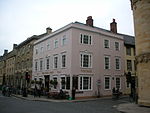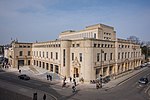Indian Institute
1883 establishments in EnglandAll pages needing cleanupDepartments of the University of OxfordEducational institutions established in 1883Grade II listed buildings in Oxford ... and 3 more
Indian Civil ServiceIndologyWikipedia introduction cleanup from May 2021

The Indian Institute was an institute within the University of Oxford. It was started by Sir Monier Monier-Williams in 1883 to provide training for the Indian Civil Service of the British Raj. The institute's building is located in central Oxford, England, at the north end of Catte Street, on the corner with Holywell Street, and facing down Broad Street from the east.
Excerpt from the Wikipedia article Indian Institute (License: CC BY-SA 3.0, Authors, Images).Indian Institute
Broad Street, Oxford City Centre
Geographical coordinates (GPS) Address Website Nearby Places Show on map
Geographical coordinates (GPS)
| Latitude | Longitude |
|---|---|
| N 51.754861111111 ° | E -1.2541666666667 ° |
Address
Oxford Martin School (Old Indian Institute)
Broad Street 34
OX1 3BD Oxford, City Centre
England, United Kingdom
Open on Google Maps








